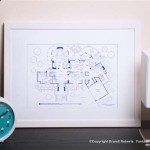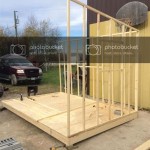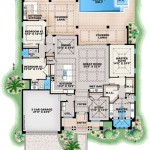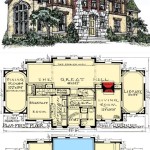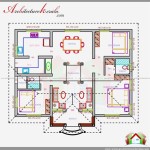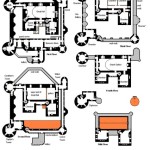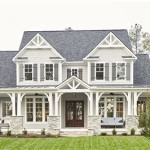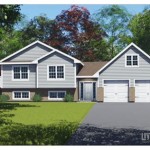Two-Story Craftsman Bungalow House Plans: A Blend of Charm and Space
The Craftsman bungalow, a style born from the American Arts and Crafts movement of the late 19th and early 20th centuries, emphasizes simplicity, functionality, and the beauty of natural materials. While traditionally associated with single-story homes, the two-story Craftsman bungalow offers a compelling alternative, combining the beloved aesthetic of the style with the increased living space required by many modern families. This article explores the key features, benefits, and considerations involved in selecting and implementing two-story Craftsman bungalow house plans.
The allure of the Craftsman bungalow lies in its inherent warmth and inviting character. The style typically features a low-pitched roof with wide eaves, exposed rafters, and a prominent front porch. Natural materials such as wood, stone, and brick are frequently utilized, both inside and out, contributing to the home's organic and grounded feel. The interior layout commonly prioritizes open living spaces, with a focus on handcrafted details and built-in elements. Transitioning this beloved style to a two-story design presents unique opportunities to expand on these core characteristics while addressing the spatial needs of a growing household.
Key Features of Two-Story Craftsman Bungalow House Plans
Several defining elements contribute to the distinctive look and feel of two-story Craftsman bungalows. These features often blend seamlessly with the surrounding environment, creating a harmonious and visually appealing dwelling.
Exterior Design: The exterior of a two-story Craftsman bungalow retains the characteristic low-pitched roofline with wide eaves, often incorporating dormers to introduce natural light into the upper story. The front porch, a signature element of the Craftsman style, remains a focal point, providing a welcoming space for relaxation and social interaction. Materials such as wood siding, stone accents, and brick foundations are commonly used to enhance the home's natural appeal. Window styles typically include double-hung or casement windows with multi-pane detailing, further emphasizing the handcrafted aesthetic. Gable details, exposed rafter tails, and decorative brackets are frequently incorporated to add visual interest and reinforce the Craftsman architectural vocabulary. Thoughtful landscaping, featuring native plants and natural stone pathways, often complements the exterior design, creating a cohesive and inviting curb appeal.
Interior Layout: While maintaining the open and flowing floor plan characteristic of the Craftsman style, two-story designs offer a clear separation between living and sleeping areas. The ground floor typically houses the main living spaces, including the living room, dining room, and kitchen, often arranged in an open-concept format to promote social interaction and a sense of spaciousness. The upper floor is typically dedicated to bedrooms and bathrooms, providing privacy and tranquility. Staircases are often centrally located and designed to be visually appealing, frequently incorporating wood railings, newel posts, and handcrafted details. Built-in elements, such as bookshelves, cabinets, and window seats, remain a hallmark of the Craftsman style, providing functional storage and enhancing the home's character. Fireplaces, typically clad in brick or stone, often serve as a focal point in the living room, adding warmth and ambiance to the space.
Material Selection: The choice of materials plays a crucial role in defining the aesthetic of a two-story Craftsman bungalow. Wood is the predominant material, used extensively for siding, trim, and interior finishes. Natural stone and brick are often incorporated as accents, adding texture and visual interest. Interior finishes typically feature natural wood trim, hardwood flooring, and handcrafted details. Lighting fixtures often incorporate warm, ambient lighting, further enhancing the home's inviting atmosphere. Energy-efficient materials and construction techniques are increasingly being integrated into Craftsman bungalow designs, ensuring sustainability and reducing energy consumption. Consideration is given to the durability and longevity of materials, ensuring that the home will withstand the test of time while maintaining its aesthetic appeal.
Benefits of Choosing a Two-Story Craftsman Bungalow House Plan
Opting for a two-story Craftsman bungalow offers numerous advantages, catering to both aesthetic preferences and practical needs.
Increased Living Space: The primary benefit of a two-story design is the significant increase in living space compared to a traditional single-story bungalow. This allows for larger living areas, more bedrooms, and additional bathrooms, accommodating the needs of a growing family or providing ample space for hosting guests. The vertical expansion minimizes the footprint of the home on the lot, maximizing outdoor space for gardens, patios, and other recreational areas. The separation of living and sleeping areas on different floors provides enhanced privacy and noise reduction, creating a more comfortable and functional living environment.
Enhanced Views: The elevated vantage point afforded by a two-story design often provides enhanced views of the surrounding landscape. This can be particularly advantageous in areas with scenic vistas, such as mountains, forests, or water bodies. Larger windows and balconies on the upper floor can be incorporated to maximize the enjoyment of these views, creating a strong connection between the interior and exterior environments. The increased natural light penetration on the upper floor can also contribute to a brighter and more cheerful living space.
Potential for Future Expansion: Two-story Craftsman bungalows often offer greater flexibility for future expansion or renovation. The attic space, if unfinished, can be converted into additional living space, such as a bonus room, home office, or additional bedrooms. The basement, if present, can be finished to create a recreational area, home theater, or guest suite. The structural integrity of a two-story design often allows for easier additions or modifications compared to a single-story structure. This adaptability makes a two-story Craftsman bungalow a long-term investment that can adapt to the changing needs of its occupants.
Considerations When Selecting Two-Story Craftsman Bungalow House Plans
While the benefits of two-story Craftsman bungalows are numerous, careful consideration should be given to several factors before selecting a specific house plan.
Lot Size and Orientation: The size and orientation of the building lot will significantly influence the design and layout of the two-story Craftsman bungalow. A larger lot allows for greater flexibility in terms of footprint and landscaping, while a smaller lot may require a more compact design. The orientation of the lot relative to the sun's path will impact the amount of natural light penetration and the energy efficiency of the home. Careful consideration should be given to the placement of windows and outdoor living spaces to maximize sunlight exposure and minimize heat gain during the summer months. Local zoning regulations and building codes must also be considered to ensure compliance with setback requirements, height restrictions, and other regulations.
Budget and Construction Costs: Building a two-story home typically involves higher construction costs compared to a single-story design due to the increased complexity of the structure and the need for additional materials and labor. It is essential to establish a realistic budget and obtain detailed cost estimates from qualified contractors before commencing construction. Factors such as the quality of materials, the complexity of the design, and the availability of skilled labor can all impact the overall cost of the project. Value engineering techniques, such as selecting cost-effective materials and simplifying the design, can help to control costs without compromising the quality or aesthetic appeal of the home.
Accessibility: The presence of stairs in a two-story home can present challenges for individuals with mobility limitations. Consideration should be given to incorporating accessibility features, such as wider doorways, grab bars in bathrooms, and the potential for future installation of a stair lift or elevator. A bedroom and bathroom on the ground floor can provide increased accessibility for individuals who may have difficulty navigating stairs. Universal design principles, which aim to create spaces that are accessible and usable by people of all abilities, can be incorporated into the design to enhance the long-term usability of the home.

Two Story Craftsman House Plans Home Residential Floor Plan Chef S Kitchen Open Concept

Half Timbered Two Story Craftsman Style Bungalow 1916 Sears Modern Home 264b187 House Plans One Vintage

Bungalow Floor Plans Style Homes Arts And Crafts Bungalows Craftsman House

1930 Two Story Craftsman Bungalow Kelsey Montgomery Ward House Plans Vintage 1930s

101 Two Story Craftsman House Plans Detailed

Craftsman Farmhouse Plan Bungalow With 5 Bedrooms 3 Bath

Craftsman House Plans Quality From Ahmann Design Inc
:max_bytes(150000):strip_icc()/SL-1873_FCP-8cf5801247c34df0b8bd839eeea78d4d.jpg?strip=all)
20 Craftsman Style House Plans We Can T Get Enough Of

House Plan 81214 Craftsman Style With 1777 Sq Ft 3 Bed 2 Bath

2 Story Craftsman Style House Plan Read Cottage

